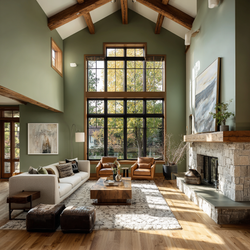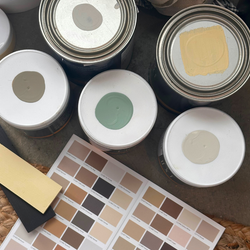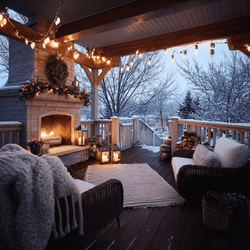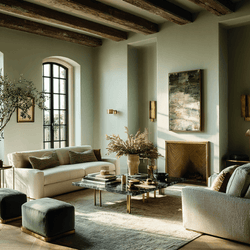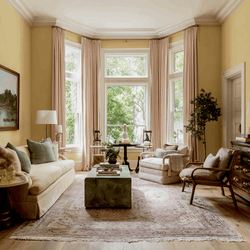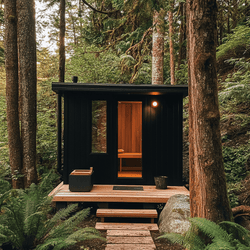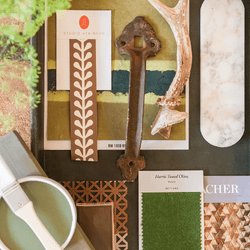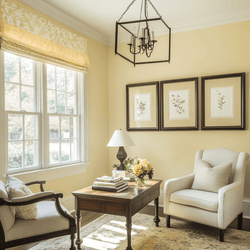The Brutalist Trend: Raw Beauty in Interior Design (and Beyond)
 If you’ve noticed an uptick in concrete textures, monolithic furniture, and minimal yet dramatic spaces in your scroll lately—you’re witnessing the resurgence of Brutalism. Once associated with post-war public buildings and raw industrial spaces, this bold aesthetic is making a striking comeback across interiors, fashion, and product design.
If you’ve noticed an uptick in concrete textures, monolithic furniture, and minimal yet dramatic spaces in your scroll lately—you’re witnessing the resurgence of Brutalism. Once associated with post-war public buildings and raw industrial spaces, this bold aesthetic is making a striking comeback across interiors, fashion, and product design.
Today, Brutalism is being revived through a fresh lens—one that celebrates its sculptural roots while adding warmth, comfort, and soul.
The Origins of Brutalism: A Brief History

Brutalism emerged in the mid-20th century, shaped by the post-WWII need for low-cost, durable architecture. The name derives from the French term béton brut, meaning "raw concrete," a concept popularized by architect Le Corbusier.

In the 1950s to 1970s, Brutalism dominated institutional and governmental architecture. Think Boston City Hall or London’s Barbican Estate—buildings known for their fortress-like presence and utilitarian appeal. While often polarizing, these structures reflected values of strength, honesty, and function over form.
What Is Brutalism in Interior Design?

Though once viewed as cold and uninviting, Brutalism is now being reinterpreted in homes, boutiques, and creative spaces. The modern take embraces the same raw materials and structural drama, but pairs them with softer textures, organic shapes, and thoughtful lighting to create interiors that are both bold and livable.
How to Modernize Brutalist Interiors (And Make Them More Approachable)

Let’s explore the evolution of Brutalism in interior design, and how you can bring its distinct character into your home—without sacrificing comfort.
1. Shift the Color Palette
Old School: Monochromatic and stark
Modern Update: Warm and tonal
-
Try warm grays, taupes, mushroom, and ivory tones
-
Sample paint colors: C2 Shiitake, C2 Paperclip, C2 Russian Olive, C2 Raku
-
Add color through texture: velvet cushions, matte ceramics, and brushed metals
2. Layer Natural Materials
Old School: Cold concrete and steel
Modern Update: Organic, earthy elements
-
Reclaimed woods, woven textures (rattan, jute), and soft textiles
-
Linen or boucle upholstery
-
Live-edge tables or natural fiber lighting add instant warmth
3. Embrace Curves and Sculptural Forms
Old School: Boxy, geometric shapes
Modern Update: Contrast with curves
-
Rounded coffee tables, arched mirrors, and globe lighting
-
Add softness and flow to break up Brutalism’s rigidity
4. Use Mood Lighting
Old School: Harsh overhead lighting
Modern Update: Ambient and layered light
-
Dimmable sconces, sculptural table lamps, and warm-toned bulbs
-
Uplighting enhances texture and shadow play
5. Add Art + Soft Furnishings
Old School: Bare, utilitarian surfaces
Modern Update: Personality and warmth
-
Oversized art, abstract prints, vintage rugs, and plush throws
-
Mix handcrafted elements with sculptural furniture for a human touch
In a world saturated with digital filters, curated perfection, and mass-produced everything, Brutalism offers something radically honest. It speaks to a desire for authenticity, permanence, and emotional weight in design. It’s tactile. It's real. And it’s having a moment.
6. Bring in Plants (But Keep Them Sculptural)
-
Think structural over frilly: snake plants, rubber trees, olive trees
-
Use raw ceramic planters and thoughtful placement
-
Adds life and architectural interest to hard-edged spaces
Brutalism Beyond Interiors
Brutalism’s influence extends into fashion, digital, and product design:

Fashion
-
Designers like Rick Owens (pictured above) and The Row draw from Brutalism’s muted tones and strong forms
-
Look for geometric accessories, chunky boots, and structural outerwear
Graphic Design

-
Brutalist websites use bold typography, grid layouts, and minimal decoration
-
A counter to overly polished digital aesthetics
Product Design

-
Furniture and decor feature monolithic shapes and tactile materials
-
Brands like Faye Toogood (pictured above) and Bower Studios reinterpret Brutalism as functional art
Keep in mind, brutalism isn’t for everyone—and that’s what makes it powerful. For those seeking spaces with emotion, drama, and permanence, Brutalism offers a raw honesty that stands in contrast to fleeting trends. When softened with warmth and intention, Brutalist design becomes not only livable but deeply expressive.


